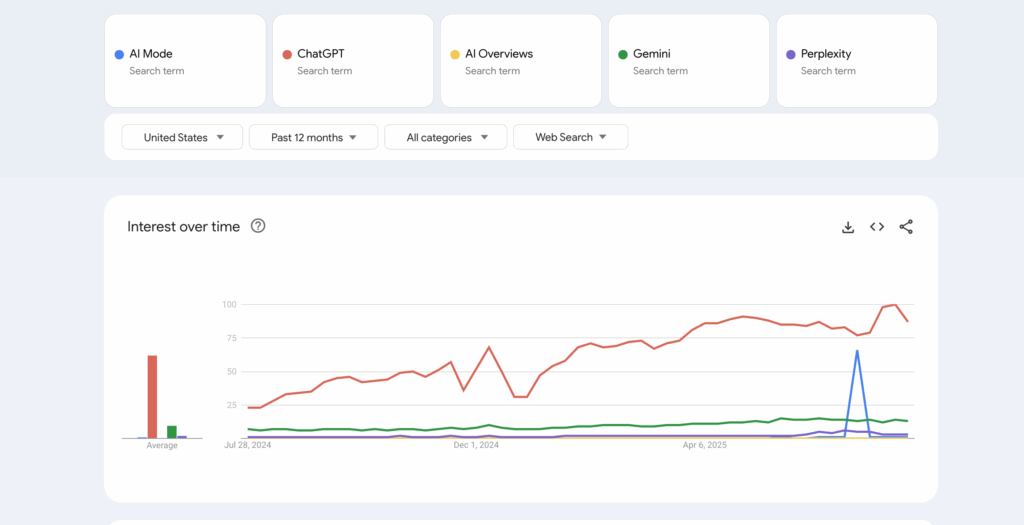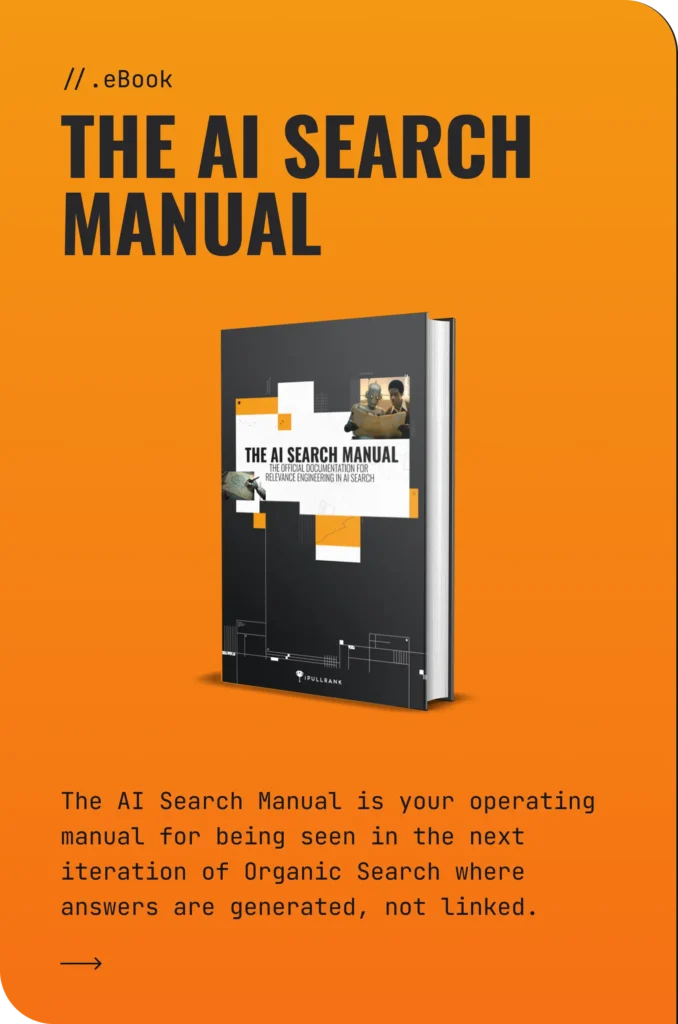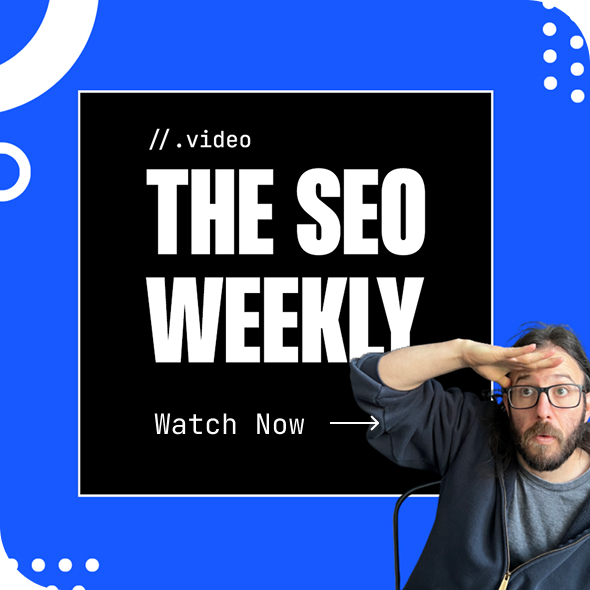TL;DR: Key Insights from the First Two Months of AI Mode Usage (May–July 2025)
- Google Trends shows that interest in “AI Mode” spiked the week of June 29 but has since dropped off, with low overall search volume compared to ChatGPT or Gemini.
- Over 50% of users tried AI Mode once and didn’t return.
- Only about 9% of users used it 5+ times, indicating that early adoption is narrow and possibly limited to SEOs and tech-savvy testers.
- Query length in AI Mode is rising slowly (ChatGPT 70 words, AI Mode 7 words, Google Search 3 words), indicating growing comfort with more complex queries.
- Searches per session jumped by 27% in mid-July (from 2.6 to 3.3 searches per session), likely tied to new feature releases, the blog promoting it, and advertising spend on AI Mode.
Note: Each of the graphs below is interactive. You can hover over them to see precise data or click on legend segments to see a different visualization of the data.
Google is in a precarious situation with AI Mode. Google has released it publicly, but it’s buried behind a tab, a search bar icon, or an AI Overview link. It’s not front and center. And it’s light on ads. That tells us something.
What’s the data saying? AI Mode is inching forward.
There’s a real tension here. Google has to innovate, but it also needs to protect its ad model. If too many users shift from traditional search to AI Mode, and it doesn’t drive the same revenue, that’s a problem.
So, the question is:
Is the lack of repeat use a reflection of the product or the way it’s being introduced?
AI Mode is still experimental and primarily driven by curious tinkerers (early adopters, ChatGPT users, and marketers, I assume). This isn’t mainstream adoption yet. But these early behaviors still offer clues about user expectations, friction points, and how marketers should be thinking about future optimization in a hybrid SERP and generative environment.
And honestly, we still don’t know Google’s ultimate plan. They recently debuted Web Guide in Search Labs, which serves as intermediate training wheels.
Remember, AI Mode is public. It was just rolled out to the UK. People are using it. AI Mode may likely be the endgame for AI Search.
Assuming that’s true, SEOs should be paying attention to how people are engaging with it.
SimilarWeb provided Elias Dabbas and our team with daily relative data points from over 100K AI Mode users between the timeframe of May 20th (AI Mode’s public launch date) to July 19th on the following metrics:
- Searches per Session: The number of searches conducted within a single session. A session includes all activity on a domain during a calendar day, ending only after 30 minutes of inactivity or when the date changes. Navigating away from the domain does not end the session—for example, if a user clicks a link from Google, then returns to Google and performs another search, it’s still part of the same session. Each time a user enters or modifies a query, whether in traditional Google Search or AI Mode, it counts as a new search.
- Average Sessions per User: The total number of sessions in AI Mode or Google divided by the number of distinct users. (Sessions ÷ Unique Users).
- Average Query Length: The average number of words in the initial search query. For AI Mode, only the first query is captured, as each follow-up query generates a new URL that is currently not trackable. In some cases, this first query may have originated in Google Search before the user clicked into AI Mode.
- AI Mode User Retention (by Days Active): The number of distinct days users accessed AI Mode within the review period. For example, 65.5% of users only used AI Mode on a single day, while 19.7% returned and used it on two separate days.
Now let’s be clear: this is a volatile snapshot — just two months of data from May to July 2025. In our analysis, we are considering the type of person who would push past the friction to utilize the functionality. We also should understand that the novelty of it could lead to experimentation as opposed to genuine, normal search behavior.
That was a major caveat that was addressed in our previous article on the referral data.
Revisit our initial referral report from the first month of data.
With the caveats laid bare, let’s examine how AI Mode usage looks after two months.
Google Trends: Most People Still Aren’t Searching for AI Mode

Before assessing how people use AI Mode, it’s worth acknowledging that relatively few people are even searching for it.
According to Google Trends data (July 2024–July 2025), “AI Mode” barely registers, even after a brief spike during the week of June 29–July 5, likely tied to the announcement of deep search and model switching capabilities via their blog.
In contrast, ChatGPT continues to dominate attention, with Gemini and Perplexity slightly behind. AI Overviews fares even worse than AI Mode.
For marketers, this suggests minimal awareness or demand among everyday users. The data that follows reflects a niche user base, not mainstream behavior.
What the Charts Show Us (and Why It Matters)
These charts provide a narrow but revealing glimpse into early AI Mode user behavior. Given how new and hidden AI Mode still is, the results aren’t shocking, but they are informative.
We would expect:
-
Low retention: The friction to discover and return to AI Mode is high.
-
Low volume: It’s not default search behavior and lacks visibility.
-
Longer queries: Users feel encouraged to ask more complex questions.
-
Higher page engagement: AI-generated summaries may drive better-qualified traffic.
The actual results align with some of these expectations. But a few standout surprises include:
-
The mid-July jump in session depth suggests that new features might improve behavior.
-
Longer time spent and more pageviews per referred session, suggesting that when users do click, they’re getting something worthwhile.
Still, everything remains highly volatile, given the limited data, small user base, and unclear user intent (testing versus actual need). Treat these as early signals, not definitive trends.
Retention: Most People Try AI Mode Once, Then Bounce
- 53% of users never return after day one.
- About 20% come back for two sessions, with diminishing returns thereafter.
- ~9% stick around for 5+ days, a small but growing power user segment.
Implications:
The novelty factor drives trial, but there’s no habit formation yet. Discoverability and friction are likely bottlenecks: AI Mode isn’t the default. Most who return are either curious marketers, SEOs, or AI experimenters. In other words, it isn’t easy to discern if people aren’t enamored with it or just don’t care.
Query Length. A Different Kind of Searcher
- ChatGPT averages ~70 words per query — much longer than traditional search.
- AI Mode sits slightly above Google, but far below ChatGPT.
- Trendline shows gradual increase in AI Mode query length, especially after July 15.
Implications:
AI Mode users aren’t yet treating it like a conversational search platform, but they might. I’d expect query lengths to grow as users realize it can handle more nuanced or compound requests. There’s still a large portion of Google users who have never used ChatGPT or any of the conversational chatbots. They don’t know that they can use natural language and comprehensive prompts to get a more detailed answer. They’re also unlikely to understand that a detailed prompt would provide a better answer.
It’s still more than a traditional Google Search. We also can’t assume that these averages aren’t impacted by significantly longer queries. In other words, perhaps the majority of first-time AI Mode users are treating it like normal Google Search, but people familiar with these LLM-based platforms are raising the average word count with much longer conversational searches.
Search Depth: More Searches per Session After July Spike
- Jump from 2.6 → 3.3 searches per session for AI Mode in mid-July.
- Spike aligns with Google’s AI Mode feature update (deep research, multi-perspective summaries).
Three possible explanations (not mutually exclusive):
- People learned about AI Mode for the first time. Started experimenting with different searches simply to get a better understanding of the tool for the very first time.
- Returning users learned about the new features and wanted to test them out to see how they differed from the initial version of AI Mode.
- The updates made the results worse. People couldn’t find a satisfying answer and returned to repeat a similar query.
Interesting note: Despite the jump, AI Mode is still ~60% lower than Google Search in search volume per session. People might generally find more satisfying answers via AI Mode than traditional search. But that will need to be proven over time.
Engagement Frequency : The Gap Remains
- Google Search still dominates here. Sessions per user are much higher.
- AI Mode users come less frequently and in smaller, more sporadic bursts.
No strong conclusion, but it reiterates that this is not yet a habitual tool. Discovery and utility aren’t driving recurring use. If we assume that the blog posts attracted a significant number of new users on July 15th (as indicated by the zoomed-in AI Mode data), then you could argue that they have minimal stickiness so far.
Are AI Mode Users More Intent-Driven?
SEOs are desperate to save the channel and the industry. If traffic from Organic Search is down, how do we justify investing in the channel? It’s a topic that I discussed with Michael King recently.
What to Watch Next: Signals That AI Mode Will Be Deployed as the Default Version of Search
- Visibility and Default Placement
- AI Mode is public, but still tucked behind a tab, a search bar button, or an AI Overview link.
- Watch for shifts in default placement. Does it load automatically? Is the button more prominent?
- Increased exposure would signal a move from an optional feature to a primary experience.
- Ads in AI Mode
- Are sponsored links or product carousels being tested in responses?
- If ad units start appearing more consistently, Google may be laying the groundwork for scale.
- Search Interest Growth
- Use Google Trends to monitor interest in “AI Mode”.
- A rise would suggest growing public awareness or more exhaustive media coverage.
- User Retention and Session Depth
- Are more users returning after their first use?
- Are session lengths or the number of searches per session increasing?
- Watch for signs that people are starting to form habits with it.
- Query Complexity
-
Are queries trending longer and more conversational over time?
- A shift toward multi-part or paragraph-style prompts may reflect growing user fluency.
-
- Engagement Quality from AI Mode Traffic
- Are users clicking through and spending more time on-site?
- Higher pageviews and longer sessions would suggest AI Mode is sending more qualified traffic.
- Product Iteration Velocity
- Keep an eye on public updates and Keyword Blog posts. VP of Search Robby Stein consistently shares new features on X.
- Faster iteration cycles typically indicate that internal confidence is growing.
2/6 File uploads in AI Mode make it easy to ask questions about your homework or course materials. On desktop, you’ll be able to upload images & PDFs – like lecture slides or class notes - to get a summary or go deeper with info from the web. pic.twitter.com/iIRxEd84Md
— Robby Stein (@rmstein) July 29, 2025
Convergence with Gemini
Does AI Mode start pulling in Gemini features or blur into the main generative experience? (See above).
Google may consolidate these tools to streamline its AI search stack.
More Mentions in Earnings Calls or Analyst Briefings
If AI Mode continues to get called out in public investor communications, it’s a signal Google sees commercial upside.
Is AI Mode Intentional Teflon?
Every product team wants stickiness. If users don’t come back, the feature didn’t land. What’s interesting about Google’s AI Mode is how carefully it’s being introduced. It’s tucked away, hard to access, and noticeably light on ads. That’s not an accident. If too many users shift over too soon and the revenue model doesn’t keep up, Google takes a hit.
So the question isn’t just “Is AI Mode sticky?” The data says no, not yet. The real question is: “Does Google even want it to be?” At least for now.







